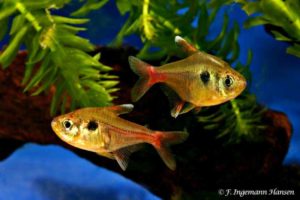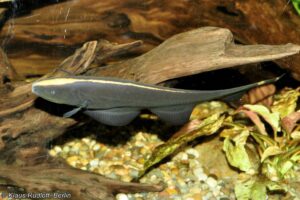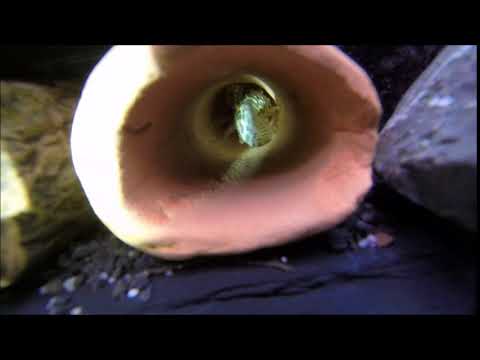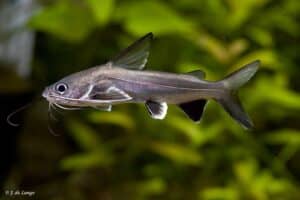Peckoltia compta – L134
Peckoltia compta was first described in 2010 by Renildo Ribeiro de Oliveira, Jansen Zuanon, Lucia Rapp Py-Daniel and Marcelo Salles Rocha. In the aquarium hobby, the fish is best known as Leopard Frog Pleco, or through its L number: L134. Officially, the L number expires after the official description but hobbyists and stores often continue to use them.
The genus name, Peckoltia, is a tribute to Gustavo Peckolt, a member of the Natural History Commission of Rondon. The species name, compta, comes from the Latin word “comptus,” meaning “ornamented” or “graceful.” This name refers to the fish’s striking and attractive color pattern.
Peckoltia compta belongs to the family Loricariidae, armored catfish, and the genus Peckoltia. The genus Peckoltia itself is part of the tribus Ancistrini. The taxonomic classification of this fish is still subject to debate and research, especially its relationship to other genera within the tribus Ancistrini.
Description
Peckoltia compta is a relatively small armored catfish with a flattened, torpedo-shaped body. The base color of the body is variable, ranging from a yellowish to a whitish hue, depending on the condition of the fish and its origin. Over this base color runs a complex pattern of black bands, twists, and dots. In young specimens, these bands are thicker and run across the entire body, while in adult fish they break up into smaller lines and dots. Fish from the Rio Jamanxim have a more spotted pattern than those from the Rio Tapajós. The head shows a similar pattern of black lines and dots. The fins are the same color and pattern as the body. The maximum length of this species is about 12 to 15 centimeters, but in aquariums they often remain slightly smaller. A pale, almost white color indicates stress.
Sex differences: Distinguishing between males and females is relatively easy in adult specimens. Adult dominant males develop sharp odontodes (small, tooth-like protrusions) on about three-quarters of their tails, a feature absent in females and non-dominant males.


Furthermore, the cloaca (the external opening of the digestive, urinary and reproductive systems) is V-shaped in males, while it is more round, U-shaped in females. Behavioral differences are especially apparent during reproduction, where males guard the eggs.
Juveniles versus adults: Juvenile Peckoltia compta, as mentioned earlier, have thicker, continuous bands on their bodies. As they age, these bands become thinner and more scattered, resulting in the more complex pattern of adult fish.
Behavior and temperament: Peckoltia compta is generally a peaceful fish, although they can exhibit territorial behavior, especially males during mating season. They are not shy and can be kept well in a community aquarium, provided there are enough hiding places. They are bottom dwellers that like to hide in crevices between rocks and wood, or in specially constructed burrows. They do not live in schools, but can be kept in small groups, provided there is enough space and hiding places for each individual.
Life expectancy: The life expectancy of Peckoltia compta in the wild is unknown. However, in an aquarium they can live for several years, with an estimated life span of several years to possibly more than 5 years, depending on care.
Biotope
Peckoltia compta is native to BrazilTapajós. Specifically , they live in the basins of the Rio Tapajós and the Rio Jamanxim, both rivers in the Amazon Basin.
Their natural habitat consists of clear, fast-flowing waters with a rocky bottom. The amount of underwater vegetation is not abundant, but rocks, wood and other substrate are present where the fish can hide. The banks of these rivers are vegetated.
Peckoltia compta lives in a tropical climate. The rivers where they live have periods of floods and droughts, typical of the Amazon.
Diet
In the wild, Peckoltia compta is an omnivore, meaning they eat both plant and animal foods. Precise details about their diet in the wild are limited, but it is likely that they consume algae, biofilm (a thin layer of microorganisms on surfaces), and small invertebrates. They scrape algae off rocks and wood, also ingesting wood fiber, which is important for their digestion.
In the aquarium, their diet should be varied to meet their needs. Suitable foods include sinking tablets or pellets specially designed for harness catfish, supplemented with frozen foods such as mosquito larvae, mysis shrimp, krill and spirulina-enriched artemia. Vegetables such as blanched spinach, kale and cucumber can also be offered. It is important not to overfeed to prevent water pollution. Dead fish or water snails are also eaten . A diet too rich in proteins and fats can be harmful. Wood fiber is important for proper digestion.

The Aquarium
For a single Peckoltia compta, an aquarium of at least 80 liters and 80 centimeters is sufficient, but a larger aquarium is always better. For several fish, especially several pairs, a considerably larger aquarium is needed, at least 120 centimeters or more, depending on the number of fish and available hiding places. The setup should mimic the natural habitat. A bottom with many crevices and hiding places is essential. Use a substrate of sand or fine gravel supplemented with rocks, wood and roots to create burrows and hiding places. Plants are not strictly necessary, but can add a natural look, provided they can withstand the somewhat stronger currents these fish prefer.
The ideal water conditions for Peckoltia compta are soft to moderately hard water with a pH between 6.0 and 7.2, and a low to moderate KH (carbohydrate hardness). The temperature may be between 25°C and 30°C . Good filtration and oxygen supply are important, as these fish appreciate a strong current.
Suitable co-inhabitants are other peaceful species that do not compete for food or hiding places. Consider small tetras and other small, peaceful fish that are not too large or aggressive. Avoid keeping aggressive or larger fish that might threaten the Peckoltia compta, or other harness catfish with similar needs to avoid competition.
Breeding Peckoltia compta – L134
Available breeding reports describe various successful breeding methods for Peckoltia compta, both in a community aquarium and in a specially equipped breeding aquarium. No single”best” method has been described.
Method 1 (community aquarium): A successful culture was reported in a companion aquarium measuring 140 x 50 x 36 cm (about 250 liters). The water parameters were a pH of 6.8 and a conductivity of 150 μS, achieved by water changes with osmosis water. The temperature was reduced from 28°C to 25°C. Filtration consisted of a filter block (5 x 35 x 20 cm) supplemented by an air pump. A breeding group of 30 adult fish (16 females and 14 males) was used. The feed consisted of a homemade shrimp mix, frozen artemia and cyclops.
Method 2 (separate breeding aquarium): Another source describes successful breeding in a smaller, specially decorated breeding aquarium with simple furnishings (gravel, cave, piece of wood). The water quality was soft water with low conductivity (110 μS) and a pH around 6.5. Feeding consisted of a varied diet of frozen foods such as artemia and cyclops, supplemented by a homemade shrimp mix. The sex ratio and whether or not the sexes were separated prior to breeding are not mentioned.
Method 3 (breeding group): Another successful breeding was conducted with a breeding group of 30 adult fish in a 120 liter aquarium, consisting of 16 females and 14 males. The fish were fed a high-protein diet (EBO Seafood Softgran and Mussel Softgran) supplemented with plant material (EBO Spirulina Softgran and Spirulina Paste). The temperature was 28°C, with weekly water changes of 50-60%.
Summary: The breeding of Peckoltia compta has proven successful with various methods and setups. A varied diet, soft water, a suitable temperature and sufficient hiding places seem to be essential factors. Separation of the sexes prior to breeding is mentioned in some descriptions, but is not necessary in all cases. A higher ratio of females in the breeding group may be beneficial.
The Spawn
Descriptions of the spawning behavior of Peckoltia compta are not completely consistent, but do give a general picture. It is reported that the colors of the fish may become more intense during spawning. One description states that a female inspects several burrows before choosing a suitable spot. The male tries to lure the female to the burrow with his filaments (the extended hairs on the tail ) . The mating itself can be somewhat rough, which can result in minor injuries to the female.
The eggs are deposited in burrows or crevices, often in a cave or under a piece of wood. The number of eggs varies, with estimates ranging from 10 to 50 eggs per clutch. The eggs are relatively large (about 3.5 mm in diameter) and dark yellow in color. The male guards the eggs after deposition and provides guarding. The eggs hatch after about 7 days. In one description, cavities 12-15 cm long and 3-4 cm wide were used.
Raising the young fish
The eggs of Peckoltia compta hatch after about 6-7 days. The larvae then live off their yolk sac for about a week before they begin to swim freely. Only the male exhibits parental care by guarding and warding the eggs until they hatch; after hatching and free swimming, there is no further parental supervision.
Initial feeding consists of very small food, such as newly hatched artemia nauplii, finely ground dry food, and pleco food tablets. The use of a separate breeding tank can increase the survival rate.
Particularities
Conclusion
Peckoltia compta (L134) is an attractive armored catfish that is relatively easy to keep, suitable for both novice and experienced aquarists. A spacious tank with soft, oxygenated water, rocky furnishings with plenty of hiding places and a varied diet are essential. Although breeding is considered moderately difficult, success is possible with the right approach. A pale color indicates stress.
Notable are the considerable color variation and sometimes rough spawning behavior. Males exhibit impressive odontodes. In general, keeping these fish is a positive experience, provided one knows their specific needs. Their popularity in the aquarium hobby confirms their relative shelf life and attractiveness.
Video
Author
John de Lange
Copyright images
Stephan – Lnummers.nl (original website no longer online)













